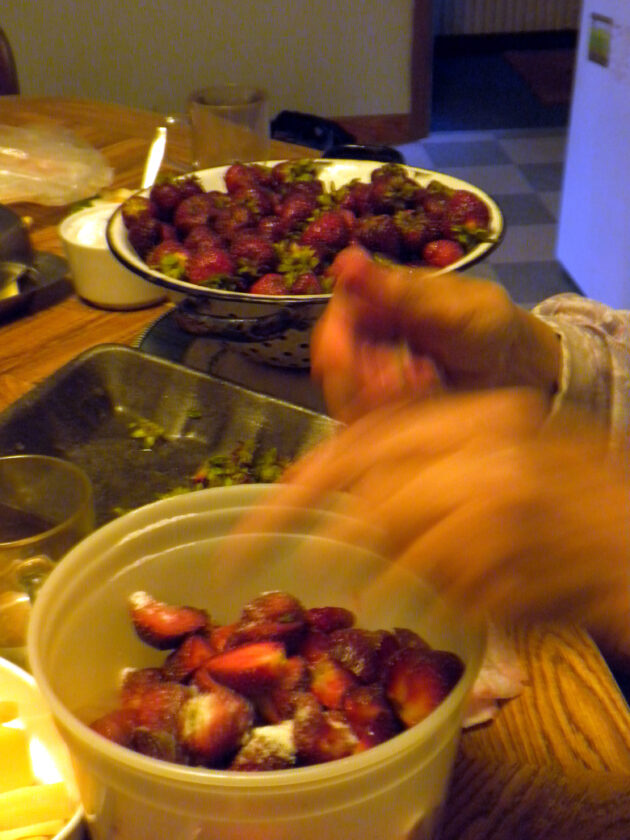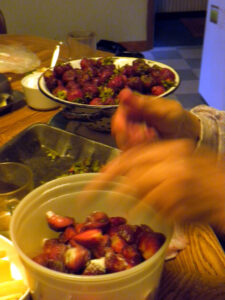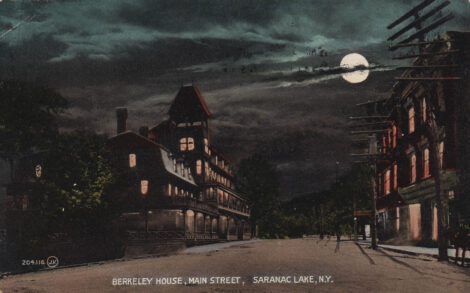August berries

Preparing berries for freezing (Provided photo — Yvona Fast)
August is midsummer. Strawberries came in June, blueberries in July. Our currants are waning. I’ve been picking raspberries off bushes along the yard and driveway. I pick a few every day; most go straight into my mouth. I try to save some to stir into a salad or put on cereal or yogurt. I bought black raspberries from Rulfs’ at the farmers’ market.
Raspberries and blackberries look alike, so here’s a trick for telling them apart: raspberries have a hollow center and blackberries do not. Both are in the genus Rubus, are members of the rose family, and grow on sprawling, thorny canes. In the spring, they have small, white, rose-like flowers. They grow vigorously in poor soil and quickly colonize any open or waste places, roadsides, construction zones, open hillsides and hedgerows. Look in woods and parks for the thorny vines or canes.
These delicate, perishable berries grow in temperate climates where the summers are not too hot, and prefer well-drained, sandy loam soils with plenty of organic material. The plant is a perennial, but the canes are biennial; they should be cut back to ground level once they have fruited, and new canes will replace them.
Because of their prickliness, raspberries and blackberries are known as briars or brambles in many places. They generally have biennial stems — called canes — that come up from a perennial root system. The berries appear on the stems the second year. Botanically, the fruit is not a true berry, but rather a collection of many drupelets. Fresh berries maintain their flavor and texture for only a couple days, so unless you plan to freeze them, only pick as much as you can use.
Worldwide, there are over 200 species of raspberries; in addition to red, they come in black, purple, yellow and even orange. Later in August will be time for the blackberries. Still later, elderberries. Our aronia is loaded with berries, but they won’t be ripe until early September.
The common red raspberry (Rubus idaeus) is indigenous to Asia Minor. Rubus occidentalis, a black raspberry, is indigenous to eastern North America. These “blackcaps” are still widely gathered in the Appalachians.
While people have been eating wild berries since prehistoric times, raspberries have only been cultivated for a few hundred years, and blackberries only in the last century. The Romans spread raspberries throughout Europe, and British colonists brought English red raspberries to America, where they quickly spread into the wild.
Blackberries are high in many polyphenols and antioxidants, naturally occurring substances which help to regulate metabolism, fight cancer, boost “good” cholesterol and promote overall good health. One of these, the anti-carcinogen ellagic acid, is extracted from berries and sold as a food supplement. They’re high in vitamin C and contain more heart-protecting fiber than any other summer fruit. Just 1 cup has half the RDA of vitamin C, as well as 10% of the folate and 22% of the fiber. They’re a good source of potassium, calcium and iron, as well as malic and citric acids.
Raspberries are a good low-calorie source of fiber, vitamin C, B vitamins and many minerals, especially manganese and potassium. They have lots of antioxidants — more than strawberries or tomatoes, according to Dutch research published in the journal BioFactors. Ellagitannins are antioxidant compounds almost exclusive to the raspberry, which are reported to have anti-cancer activity. The best known of these is ellagic acid, which helps neutralize free radicals, thus preventing damage to cell membranes. Other beneficial flavonoids in raspberries include quercetin and kaempferol. These anthocyanins give raspberries their bright red hue.
Raspberries’ antimicrobial properties help prevent overgrowth of bacteria and fungi, such as the yeast candida, which causes vaginal infections. And medical studies published in the Archives of Ophthalmology, June 2004, have shown that fruits like raspberries and blackberries can help stave off macular degeneration.
Pick gently; these berries are fragile. They’re best eaten fresh just as they are, or with whipped cream or ice cream. They’re also good in jam, compotes, pies, cobblers and tarts, or mousses.
If buying berries, look for dry berries that are not too soft, with no trace of mildew. Store in the refrigerator, but keep no longer than a day or two.
–
Fresh Greens and Berry Salad
–
Ingredients:
1/4 cup slivered almonds
1 tablespoon olive oil
1 tablespoon fruit vinegar (such as raspberry, blackberry or peach)
1/2 teaspoon salt
1 small garlic clove, crushed
8 ounces mixed salad greens
6 ounces berries (raspberries, blackberries, blueberries, or a combination)
2 green onions
1 small cucumber
Directions:
Toast almonds in a dry skillet for 1 – 2 minutes or until fragrant. Set aside.
Prepare the light vinaigrette dressing by combining oil, vinegar, salt and garlic. Set aside.
Cut off ends from green onions and slice. Peel and chop cucumber.
In salad bowl, combine greens with dressing. Stir in onions, cucumber, berries and toasted almonds. Garnish with additional berries.
Serves 2.
Option: omit almonds; add 1 cup cooked, shredded chicken breast (can be leftover from another meal).
–
Berry-Peach Shortcake
–
Ingredients:
2 baking powder biscuits
1 peach
1 cup berries (I used 1/2 cup each blackberries and raspberries)
1/2 plain Greek yogurt, creme fraiche or sour cream
1 tablespoon maple syrup
1 tablespoon chopped pecans (optional)
Directions:
Prepare baking powder biscuits according to your favorite recipe.
Wash fruit under cool water. In bowl, slice the peach; peel if you wish; add berries and combine. In a small bowl, combine yogurt or sour cream and maple syrup. Fold into the fruit.
Split the biscuits and place one in each dessert bowl. Top with fruit mixture and sprinkle with chopped nuts, if using.
Serves 2.
——
Author of the award-winning cookbook Garden Gourmet: Fresh & Fabulous Meals from your Garden, CSA or Farmers’ Market, Yvona Fast lives in Lake Clear and has two passions: writing and cooking. She can be found at www.yvonafast.com and reached at yvonawrite @yvonawrites.




